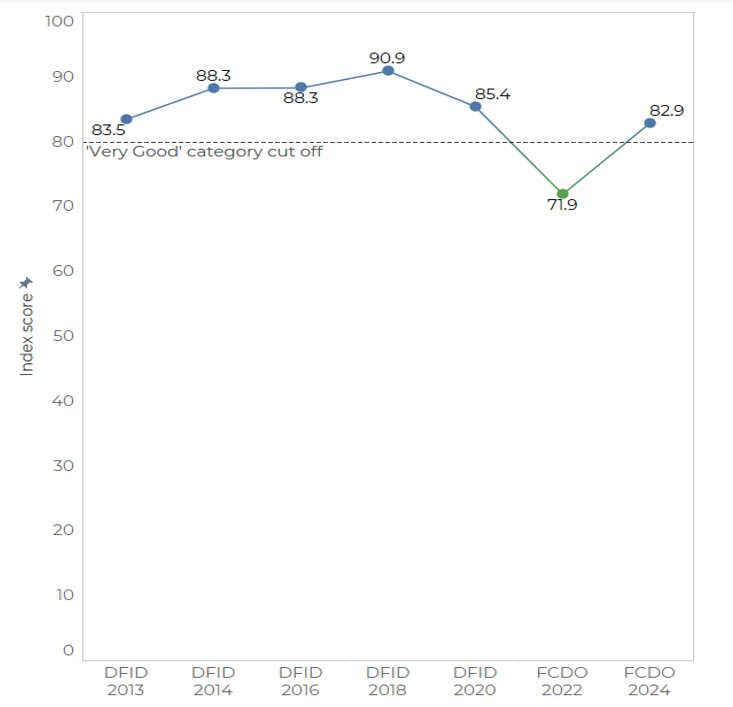Launch of the 2024 Aid Transparency Index: a look at the UKs performance
Publish What You Fund’s launch of the bi-annual Aid transparency Index is today. So how has the UK faired against its transparency commitments?
UK aid has evolved in recent years. There have been cuts to the aid budget, as well as a shift away from a development focus and towards aid being used for UK interests such as refugee costs and security spending.
Bond members may recall the Transparency Working Group raising the alarm in previous years about the lack of publicly available information on these changes, particularly following the merger of The Foreign and Commonwealth Office (FCO) and Department for International Development (DFID) to form the Foreign, Commonwealth and Development Office (FCDO).
The lack of transparency has meant that tracking these changes, and their effect on aid delivery and impact has been difficult.
Publish What You Fund’s 2024 Aid Transparency Index, the only independent measure of global aid transparency, tells us how the UK is fairing. The team began research for the 2024 Index in November and the results are being launched today. The main data source used for the Index is published to the International Aid Transparency Initiative (IATI) standard.
UK aid context
The UK is a prominent bilateral player on the global stage, despite the recent aid cuts. In 2023, the United Kingdom ranked 5th in terms of Official Development Assistance (ODA) volume among Development Assistance Committee (DAC) members and 9th among DAC member countries when ODA is taken as a share of Gross National Income (GNI). But how does UK aid perform against its development targets, where is aid now being channelled and what are its main priorities in the coming years? To answer these questions, we need information on FCDO’s forward looking budgets, aid strategies and results, amongst other data.
The UK’s commitment to transparency has fluctuated. According to the latest UK aid strategy, released in 2022, the four main areas of focus are: building investments, women & girls, fast tracking humanitarian assistance and climate change. Within this strategy, there is little mention of improving transparency. However, since December 2023, the UK has been signed up to an aid transparency commitment as part of the Open Government Partnership Plan, chiefly to reach a level of ‘Very Good’ in the 2024 Aid Transparency Index. Has this been achieved?
Index findings
The 2024 Index findings see the UK FCDO re-join the “Very Good” category for the first time since the merger, meeting ITS transparency target. FCDO gained 10 points to score 82.9 in total. While it is an impressive gain from the dip in score in 2022, it remains below the score achieved by DFID in 2020.

The FCDO scored above average across all five components measured by the Index, but particularly in the finance & budgets component. Notably, here it improved its forward-looking total and disaggregated budgets. In the project attributes component, it improved its conditions data, adding details on its aid conditions for the first time. It also improved the quality of its activity descriptions.
But further improvements can still be made. The FCDO is under-performing comparatively to other agencies in the 2024 Index in several areas, including disclosing the names of participating organisations (which were only published for 76% of its activities) and their recognised references (published for 67% of its activities). This information is important because it helps data users track flows of aid down the delivery chain.
FCDO can also improve the publication of other basic information, such as the finance and flow types of its funding (these were only published for around 70% of activities). This information tells a user how concessional FCDO’s funding is and whether it is aligned with Official Development Assistance principles.
In the performance data component, the FCDO could improve its score by improving the publication of its results data or documents across all IATI activities, as these were available for less than half of its activities. It could also ensure that all available pre-project impact appraisals include a full analysis of potential positive and negative externalities.
Of the results, Gary Forster, CEO of Publish What You Fund, said:
It’s really positive to see the efforts which FCDO have undertaken in order to regain their position in the very good category of the Aid Transparency Index. After a few difficult years where we saw not only a reduction in activity level transparency, but also a deterioration in the way FCDO engaged with civil society, we’re happy that that phase is now behind us. It’s a credit to the FCDO Transparency Team that they’ve taken such a laser focussed approach to address the recommendations we laid out in the 2022 Aid Transparency Index.
FCDO’s transparency is improving thanks to the UK government’s renewal of internal commitments to work with CSOs and set targets that can be monitored externally. However, FCDO has not yet regained the level of transparency of DFID, so continued monitoring is essential particularly in the fast-changing environment of aid and development.
Join us on Tuesday 16 July at 9.30 EDT / 2.30 BST for the launch of the 2024 Aid Transparency Index.
The event will be hosted by Brookings Center for Sustainable Development in Washington DC and online. It will provide an opportunity to find out which of the 50 major aid and development agencies that we’ve assessed will top this year’s rankings. We’ll also be hearing a range of global perspectives on transparency tools that when joined up can help countries, donors, and citizens focus on which elements of the Sustainable Development Goals are on track, which aren’t and where the effort needs to be. Registration and speaker details are here.
Category
News & Views



